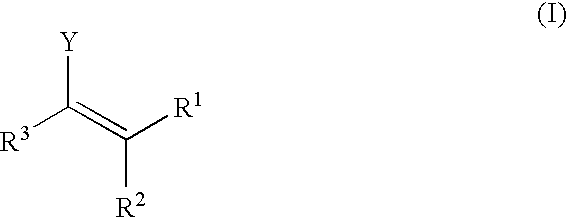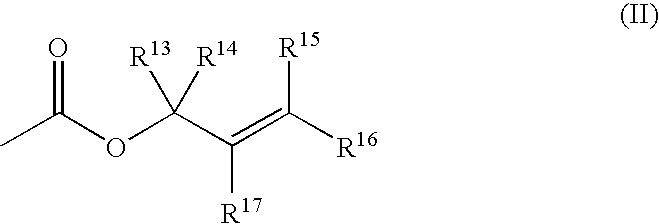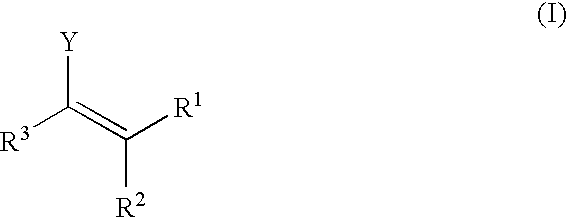Enantioselective, catalytic allylation of ketones and olefins
a technology of olefins and ketones, applied in the field of enantioselective allylation reactions, can solve the problems of current limitations and large effort in expanding the scope of transformation
- Summary
- Abstract
- Description
- Claims
- Application Information
AI Technical Summary
Benefits of technology
Problems solved by technology
Method used
Image
Examples
example 1
[0100]
TABLE 1Ligand Screen in enantioselective allylation.EntryLigandTime (h)% yielda% e.e.b1(R,R) - Trost Ligand (3)59264c2(R)-BINAP (4)576 2c3(R,R)-Me-DUPHOS (5)566 04(R,R)-DIOP (6)259 2c5(R)-MOP (7)347136(R)-QUINAP (8)297617(R)-Ph-PHOX (9)29565c8(S)-Bn-PHOX (10)594639(R)-i-Pr-PHOX (11)29583c10(S)-t-Bu-PHOX (12)29688aGC yield relative to an internal standard (tridecane).bEnantiomeric excess (e.e.) measured by chiral GC.c(R)-2 produced as the major product.
[0101]The reactions of Table 1 were conducted using the general procedure for the Asymmetric Allylation of Allyl Enol Carbonates, as follows.
[0102]General Procedure for the Asymmetric Allylation of Allyl Enol Carbonates. A 50 mL round bottom flask equipped with a magnetic stir bar was flame dried under vacuum. After cooling under dry argon, catalyst (0.025 mmol, 0.025 equiv) and chiral ligand (0.0625 mmol, 0.0625 equiv) were added. After the flask was flushed with argon, solvent (30 mL) was added and the contents were stirred at ...
example 2
[0103]
TABLE 2Enantioselective Enol-Carbonate AllylationEntrySubstrateProductTime [h]Yield [%]ae.e. [%]b 1 2c 3e 2 5 98585908788 (96)d89 4 5f 6 7R = CH2CH3R = t-BuR = CH2PhR = (CH2)3OBn 210 2 29655g968792828588 8f 88991 9 1949210 1878611 1918912h13hR = HR = OCH3 2 8879491911415n = 1n = 2 6 281908779aIsolated yields.bMeasured by chiral GC or HPLC.cPerformed on 5.1 mmol scale.dIn parentheses is the % e.e. after one recrystallization of the corresponding semicarbazone.eReaction performed at 12° C. (GC yield).fPerformed with 5 mol % Pd2(dba)3 and 12.5 mol % (S)-t-Bu-PHOX.gIsolated yield after conversion to the corresponding diketone via Wacker oxidation.hPerformed at 10° C.
[0104]The reactions of Table 2 were performed using 1.0 mmol of substrate in THF (0.033 M in substrate) at 25° C. with Pd2(dba)3 (2.5 mol %), (S)-t-Bu-PHOX (6.25 mol %), unless stated otherwise.
example 3
[0105]
TABLE 3Enantioselective Enol-Silane Allylation.EntrySubstrateProductTime [h]Yield [%]ae.e. [%]b12R = CH3R = CH2CH323959687923c4799142998156n = 1n = 22394968679aIsolated YieldsbMeasured by chiral GC or HPLCcReaction performed with dimethallyl carbonate (1.05 equiv)
[0106]The reactions of Table 3 were performed using 1.0 mmol of substrate in THF (0.033 M in substrate) at 25° C. with Pd2(dba)3 (2.5 mol %), (S)-t-Bu-PHOX (6.25 mol %), diallyl carbonate (1.05 equiv) as an allylating reagent, and TBAT (35 mol %) unless stated otherwise.
Characterization Data for Products Listed in Table 3:
[0107]
[0108]1H NMR (300 MHz, CDCl3) δ 5.75–5.61 (m, 1H), 5.05 (s, 1H), 5.01 (m, 1H), 2.40–2.31 (m, 3H), 2.21 (dd, J=13.8, 7.5 Hz, 1H), 1.78 (m, 5H), 1.56 (m, 1H), 1.06 (s, 3H); 13C NMR (75 MHz, CDCl3) δ 215.4, 133.7, 117.9, 48.4, 41.9, 38.8, 38.5, 27.4, 22.6, 21.0; IR (Neat Film NaCl) 2934, 2865, 1707, 1451, 912 cm−1; HRMS m / z calc'd for C10H16O [M]+: 152.1201. found 152.1204; [α]D28 −22.90° (c 2.09,...
PUM
| Property | Measurement | Unit |
|---|---|---|
| temperature | aaaaa | aaaaa |
| temperature | aaaaa | aaaaa |
| mol % | aaaaa | aaaaa |
Abstract
Description
Claims
Application Information
 Login to View More
Login to View More - R&D
- Intellectual Property
- Life Sciences
- Materials
- Tech Scout
- Unparalleled Data Quality
- Higher Quality Content
- 60% Fewer Hallucinations
Browse by: Latest US Patents, China's latest patents, Technical Efficacy Thesaurus, Application Domain, Technology Topic, Popular Technical Reports.
© 2025 PatSnap. All rights reserved.Legal|Privacy policy|Modern Slavery Act Transparency Statement|Sitemap|About US| Contact US: help@patsnap.com



